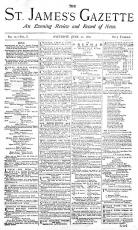Social/Political Orientation of Victorian Publications that Published Critical Responses of Wilde's Picture of Dorian Gray
Created by Emily Bremnre on Tue, 04/27/2021 - 18:44
Contextual overview of the Victorian publications that published critical reviews of Wilde's The Picture of Dorian Gray and the politics that swayed public opinion.
Timeline
Chronological table
| Date | Event | Created by | Associated Places | |
|---|---|---|---|---|
| Winter 1842 |
'Punch' Magazine is Taken Over by Bradbury and EvansThe first issue of the magazine Punch was published on July 17, 1841, and though it was well-received, it did not sell enough copies to cover the costs of production. In December of 1842, the printing and publishing firm Bradbury and Evans--the company that also published the novels of Charles Dickens and William Makepeace Thackeray--took over the magazine. Mark Lemon, co-founder and shareholder of the magazine remained Punch's editor. Under his direction, Punch was a strongly radical publication, often printing political satire such as Thomas Hood's "The Song of the Shirt" or Robert Jacob Hammerton's famous cartoon, "Captial and Labour." Sources: |
Emily Bremnre | ||
| Summer 1877 |
'The Daily Chronicle' Becomes a National DailyIn 1876, Edward Lloyd bought the London Daily Chronicle and Clerkenwell News and it soon transformed from a 4-page weekly to a news publication that gained national popularity. The newspaper reported broad news coverage, art criticism particularly in literature and theatre, and the perspectives of plain-spoken leaders such as John O'Connor Power, a radical Liberal member of Parliament from 1874-1885. Though claiming to be Liberal, the paper often took a perspective further left than both center and the Liberal Party, and the views expressed often aligned with those of the Labour Party. Regardless of political affliation, the paper was a huge success and reached a wide audience. In 1896, a journal titled Book Bits reviewed The Daily Chronicle writing that "Its strength seems to lie outside politics, for it is read, not for what it says about Liberal or Conservative, nor for the sensationalism which is the mainstay of some other papers, but chiefly for its accurate representation of what is going on around us.” Source: https://web.archive.org/web/20151118042738/http://www.edwardlloyd.org/dc... |
Emily Bremnre | ||
| 31 May 1880 |
The First Issue of the 'St. James's Gazette' is PublishedHenry Hucks (H.H.) Gibbs founded the St. James's Gazette out of the Paul Mall Gazette which had just been handed over to Henry Yates Thompson, the son-in-law of former owner George Smith. Thompson and his editor John Morely wanted to make Pall Mall a more progressive and radical paper, however, this goal was never brought to fruition, as Gibbs and his editor Frederick Greenwood took a very conservative approach to the St. James's Gazette, even becoming one of the first magazines to publicly support the Imperialist movement.
Sources: http://www.artandpopularculture.com/St._James_Gazette |
Emily Bremnre |



